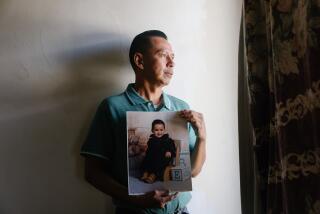Mental illness and lessons from Kelly Thomas’ last cry for help
As Father’s Day approaches, I find myself thinking a lot about the anguished cries of 37-year-old Kelly Thomas in his last moments of consciousness. “Dad! Dad!” he screamed as police fired Tasers at him and beat him with their flashlights on a Fullerton street.
The first time I heard that plaintive cry for help on my car radio, I had to pull over to compose myself. As a former emergency room physician, I’m not particularly squeamish. But as a father of two and a pediatrician who has cared for innumerable children with “developmental issues,” I found that Thomas’ pleas for help from his father (who was nowhere nearby) really got to me.
Thomas suffered from schizophrenia, the sort of illness that leaves parents puzzled and helpless. By all accounts, the father that Thomas called out to cared immensely about his son’s well-being and had tried repeatedly to get him help. But there is far too little education about the early signs of mental illness and what kinds of interventions can make a difference, and it can be difficult to find appropriate help for a troubled child or adolescent.
Here’s what I hope: that just as the Rodney King video led to an important national conversation about race, the horrific video of Thomas calling out to his father for help will lead to a national conversation about mental illness.
Not only do we need to improve services for the homeless and mentally ill, but also to teach parents, educators and healthcare professionals to recognize signs of trouble so they can intervene earlier and perhaps help prevent more young people from ending up on the streets the way Thomas did.
As a science and policy researcher who studies the health effects of early events on lifelong outcomes, I know that early intervention can often prevent the progression of mental illness, and it can certainly help lessen the severity of symptoms. More than 20% of adolescents in the U.S. have a diagnosable mental health problem, and research suggests that some 50% of lifetime mental health problems can be diagnosed by age 15 and 75% by 24. Mental health issues are the leading cause of disability for Americans 15 to 44 years of age, but the early signs are often overlooked, and problems go unrecognized and untreated until a child is expelled from school or attempts suicide. Even then, finding appropriate treatment can be close to impossible.
Over the last several decades we have witnessed not only an expanding number of people with common mental health diagnoses — such as ADHD, depression or anxiety disorders — but also more severe forms of mental illness including autism, schizophrenia and severe depression. It is more and more common for young children to be kicked out of preschool for “behavioral issues” that aren’t recognized as the precursors of more serious mental health problems. Symptoms are missed and mental illnesses often ignored in early stages when intervention can be the most successful, and even when they are recognized and parents seek help, the healthcare system often fails to provide early and appropriate treatment. Researchers at the National Institutes of Mental Health and Centers for Disease Control and Prevention have documented that less than 50% of children and youths with mental and behavioral problems receive appropriate care, especially in underprivileged communities.
The best way parents and friends can respond to signs of mental health problems is by recognizing warning signs and intervening early. Every child has bumps along the road to adulthood, but some things to watch for include:
• Problems “getting along” across a variety of settings, such as at school, at home or with peers.
• Changes in appetite, sleep or concentration.
• Social withdrawal, or fearful behavior toward things your child normally is not afraid of.
• Returning to behaviors more common in younger children, such as bed-wetting.
• Signs of being upset, such as sadness or tearfulness.
• Signs of self-destructive or risky behavior, such as head-banging, cutting or a tendency to get hurt often.
• Excessive or unusually early experimentation with alcohol or drugs.
• Repeated thoughts of or conversations about death.
When parents see such signs, it’s important to keep communication lines open, and when they break down, as they will in even the best of relationships, to encourage the child or young adult to talk with another trusted and responsible adult — a teacher, relative, family counselor or pediatrician. Although it’s not always possible to prevent mental illness from developing, early recognition of warning signs can limit the severity and prevent catastrophic outcomes.
While no one can know if getting Thomas services when he was much younger would have altered his own mental health trajectory, I hope his death strikes a chord with parents, educators, medical professionals and anyone else in a position to intervene in the lives of troubled children and adolescents. Although it’s critical to improve services for people who are mentally ill and homeless today, a more lasting and greater effect will be seen when we take the rising rate of mental health problems in our children seriously and resolve to address their root causes.
It has been many weeks now since I heard Thomas cry for his father’s help. We fathers — and mothers, aunts, uncles, teachers and others — need to heed that call. It’s too late to help Thomas, but it’s not too late to prevent the next such tragedy.
Neal Halfon is a pediatrician and professor of pediatrics, health services and public policy at UCLA.
More to Read
A cure for the common opinion
Get thought-provoking perspectives with our weekly newsletter.
You may occasionally receive promotional content from the Los Angeles Times.






